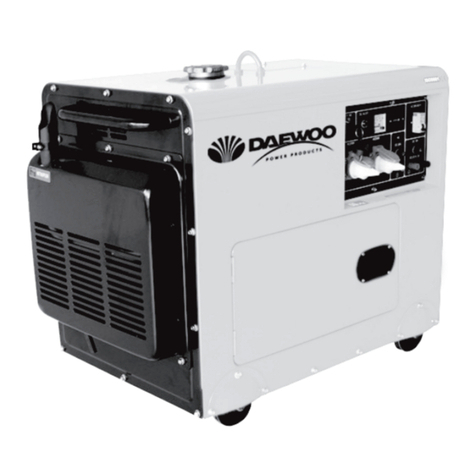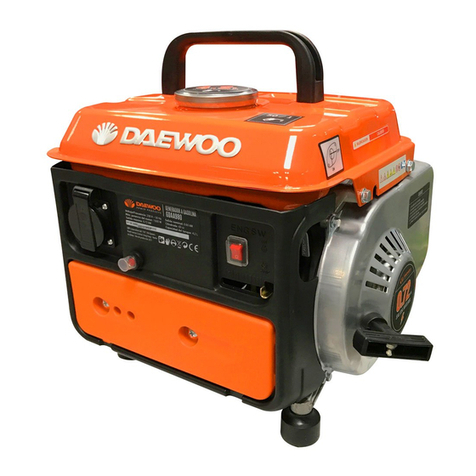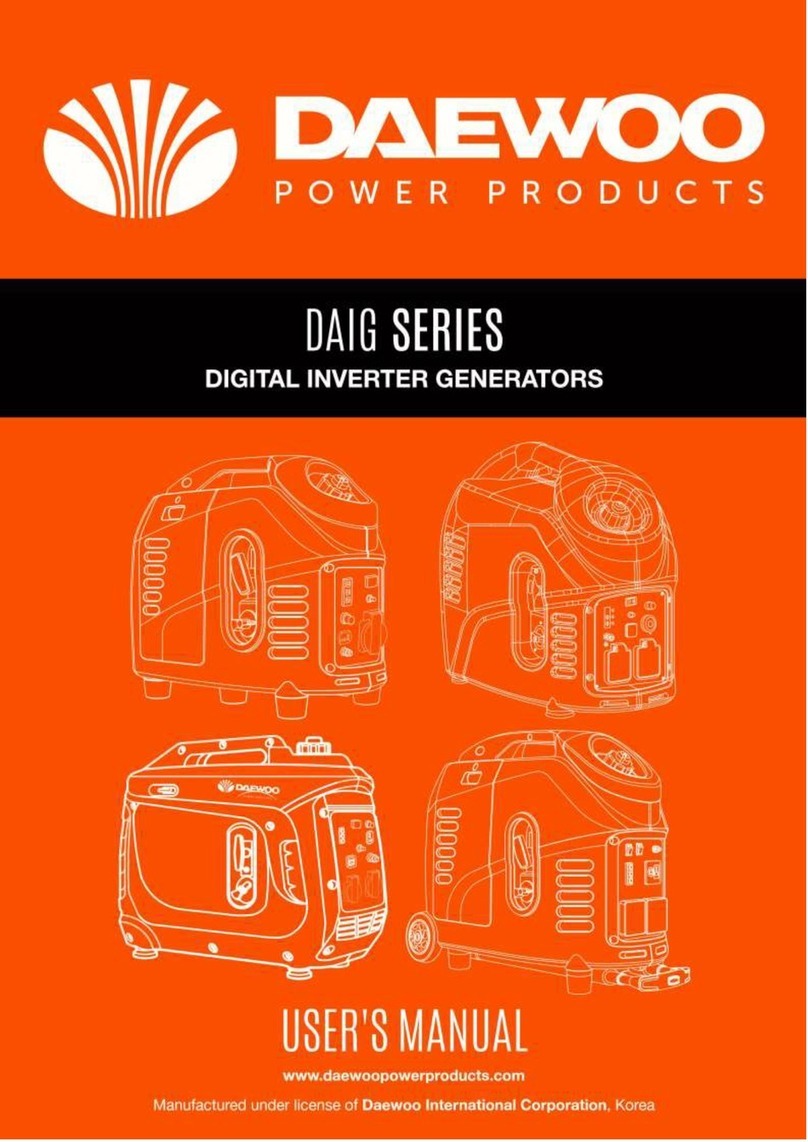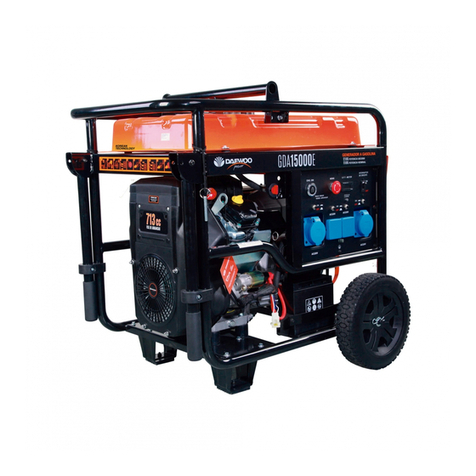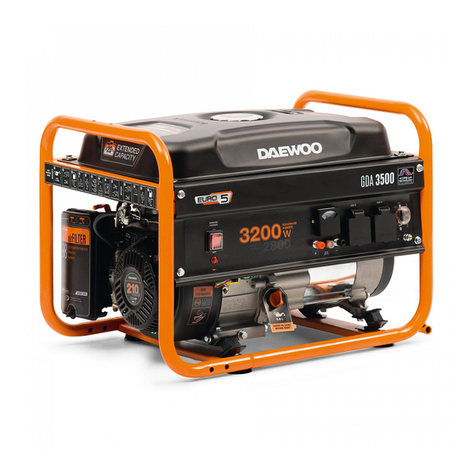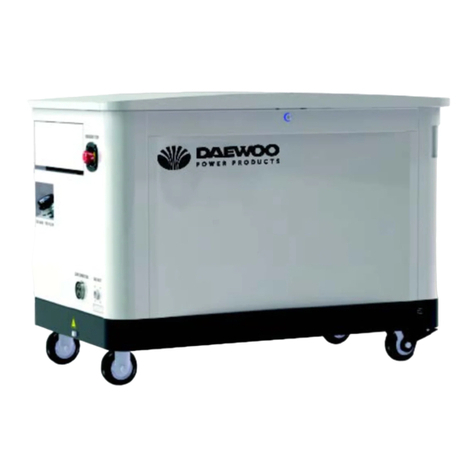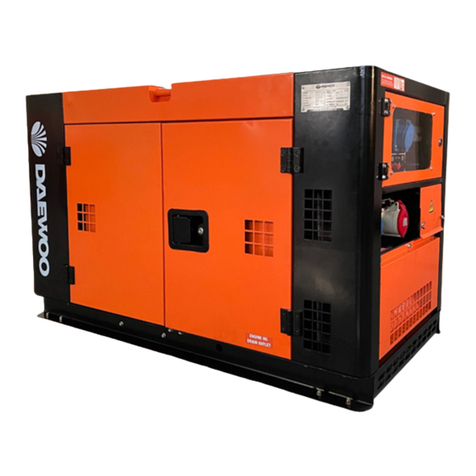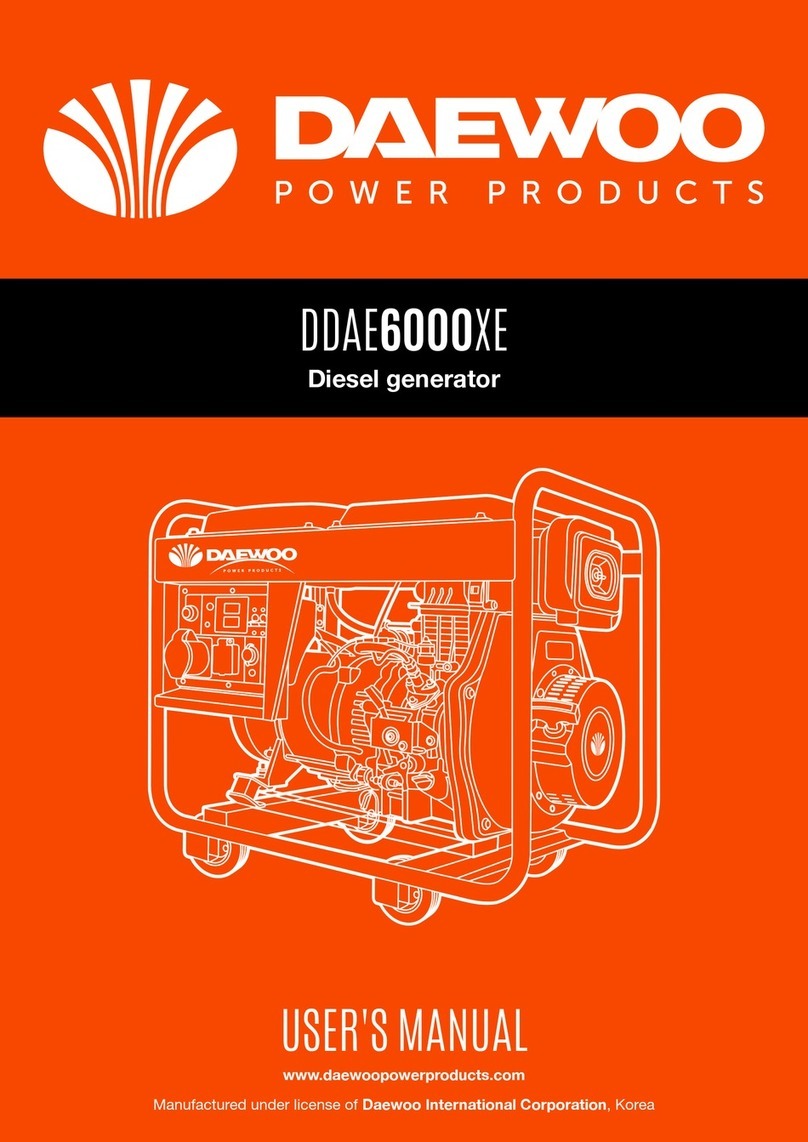
1
1. SAFETY AND WARNING...........................................................................................................................2
2. GENERAL INTRODUCTION.....................................................................................................................6
3. OPERATION INSTRUCTION FOR FIRST START.....................................................................................8
4. MAINTENANCE.......................................................................................................................................14
5. TECHNICAL DATA...................................................................................................................................17
6. DIGITAL PANEL.......................................................................................................................................21
7. EXPLODED VIEW AND PARTS LIST......................................................................................................28
8. EC.............................................................................................................................................................48
9. WARRANTY.............................................................................................................................................49
INDEX
1. SAFETY AND WARNING
The operator of the machine:
Is responsible for and has a duty of care in making sure that the machine is operated safely and
in accordance with the instructions in this user manual.
Should never leave it in a condition, which would allow an untrained or unauthorised person/s
to operate this machine.
Take all due care and diligence for the safety of and with regard to those around whilst using the
machine, to include but not limited to;
Elderly, children, pets, livestock and property.
Some or all of the following PPE, warning signs and symbols may appear throughout this
manual and you must adhere to their warning/s. Failure to do so may result in personal injury.
Personal Protective Equipment (PPE)
Before operation and maintenance for the generator sets, please read carefully about this
manual and make sure a good understanding of this operation manual and other documents
which attached with the engine.
Correct installation of the generator set is the precondition of normal operation. Qualied spare
parts shall be used for maintenance to ensure good running condition and long life expectancy
The generator set shall be operated only by the staffs who have received training on the
operation and the repair shall be made by the authorized staffs. Operator and maintenance staff
shall be clear about safety and preventive actions and operation maintenance procedure.
The generator sets can only be started under safety conditions. Please do not start the
generator sets when any abnormal condition has been found so that to avoid accidents.
When clean, maintain and repair the generator sets, please shut down the generator set and cut
off the connection of negative polar of the battery or dismantle battery connecting cable, and
place warning label at the relative place so that to avoid accident.
The exhaust air discharged from engine is harmful for people’s health. All of the generator sets
installed indoors shall discharge the exhaust gas to outside doors.
During the period of generator set running, the exhaust pipe and silencer will generate high
temperature. Therefore when the generator set is installed, these parts need to be covered with
insulation materials and be kept far away from inammable materials. Please ensure good
ventilation and organized environment for the generator set’s installation room. Please do not
place inammable materials and explosives (liquid) near the engine.
Smoking, spark over, and other re lighting behaviors are not allowed in the area which is close
to the battery and fuel because the mixture of volatilization from fuel and hydrogen generated by
battery charging process will cause explosion when it meets sparkle or naked ame.
The generator set installation room shall be facilitated with BC and ABC re extinguisher, and
operators shall be familiar with the knowledge on how to use it.
When fan protection cover or other protection cover has been detached, please do not try to
start the generator set; and when the generator set has to be started, please don’t put your hand
in the area where the protection cover is missing or make repair around these areas. please keep
your palm, arm, long hair, jewelry and loose clothes far away from belt pulley, belt and other
power transmission parts.
When working in the generator set installation room, please ware working clothes, gloves and
hat. After the generator set being started, please don’t try to open the cover of the radiator
before the anti‐freeze fully cooled down, so that to avoid steam (hot water) burst forth to hurt
people. Please don’t swallow or let your skin contact with the harmful materials such as fuel,
anti‐freeze, lubricant and electrolyte.
When you skin is spattered with these kinds of liquids, please use plenty of water to rinse.
Long time stay in high noise level environment will cause harm to your hearing. If you have to
work around the generator set frequently, you’d better ware the device to protect your ear.
When the generator set need to make cable connections to output power, the operation shall
conform to the condition, specication, standard related to power distribution. Qualied cable
shall be used to make power distribution.
When the installation of generator set involves with welding, please do not connect to the
ground circuit or make grounding through generator set (engine) so that to avoid the big current
generated from welding operation hurt the electric appliance, bearing and bearing bush etc.
inside of the generator set. Please ensure the safety of generator set and reliable grounding.
SAFETY LABELS INFORMATION
TRANSPORT WARNING
• Never lift the generating set by attaching to the engine
or alternator lifting lugs, instead use the lifting points on the
base frame or canopy.
• Ensure that the lifting rigging and supporting structure is
in good condition and has a capacity suitable for the load.
• Keep all personnel away from the generating set when it
is suspended.
MECHANICAL WARNING
• Do not attempt to operate the generating set with the
safety guards removed. While the generating set is run
ning do not attempt to reach under or around the guards
to do maintenance or for any other reason.
• Keep hands, arms, long hair, loose clothing and jewel
ers away from pulleys, belts and other moving parts.
SAFEGUARD WARNING
• Generating sets that are not equipped with sound att
enuating enclosures can produce noise levels in excess
of 105 dB (A). Prolonged exposure to noise levels above
85 dB (A) is hazardous to hearing.
• Wear protective clothing including gloves and hat whe
n working around the generating set.
• If equipped keep access doors on enclosures closed and locke
d when not required to be open.
• Avoid contact with hot oil, hot coolant, hot exhaust gases, hot
surfaces and sharp edges and corners.
Blown Air Drying
Remove the covers from all apertures to allow the escape of the water-laden air. During drying,
air must be able to ow freely through the generator in order to carry off the moisture.
Direct hot air from two electrical fan heaters of around 1-3 KW into the generator air inlet aper-
tures. Ensure the heat source is at least 300mm away from the windings to avoid over heating
and damage to the insulation.
Apply the heat and plot the insulation value at half hourly intervals. The process is complete
when the parameters covered in the section entitled, 'Typical Drying Out Curve', are met.
Remove the heaters, replace all covers and re-commission as appropriate.
If the set is not to be run immediately ensure that the anticondensation heaters are energized,
and retest prior to running.
Shirt Circuit Method
NOTE: This process shou ld only be performed by a competent engineer familiar with safe
operating practices within and around generator sets of the type in question. Ensure the gene-
rator is safe to work on, initiate all mechanical and electrical safety procedures pertaining to the
genset and the site.
Bolt a short ci rcuit of adequate current carrying capacity, across the main terminals of the
generator. The shorting link should be capable of taking full load current.
Disconnect the cables from terminals "X" and "XX" of the AVR.
Connect a variable de supply to the "X" (positive) and "XX" (negative) eld cables. The de
supply must be able to provide a current up to 2.0 Amp at 0-24Volts.
Position a suitable ac ammeter to measure the shorting link current.
Set the de supply voltage to zero and start the generating set. Slowly increase the de voltage to
pass current through the exciter eld winding. As the excitation current increases, so the stator
current in the shorting link will increase. This stator output current level must be monitored, and
not allowed to exceed 80% of the generators rated output current.
After every 30 minutes of this exercise: Stop the generator and switch off the separate excita-
tion supply, and measure and record the stator winding IR values, and plot the results.
The resulting graph should be compared with the classic shaped graph. This drying out proce-
dure is complete when the parameters covered in the section entitled 'Typical Drying Out
Curve' are met.
Once the insulation Resistance is raised to an acceptable level minimum value 10MΩ - the de
supply may be removed and the exciter eld leads "X" and "XX" re-connected to their terminals
on the AVR.
Rebuild the genset, replace all covers and re-commission as appropriate.
If the set is not to be run immediately ensure that the anticondensation heaters are energised,
and retest the generator prior to running.
Typical Drying Out Curve
Whichever method is used to dry out the generator the resistance should be measured every
half-hour and a curve plotted as shown.(Fig 9)
The illustration shows a typical curve for a machine that has absorbed a considerable amount
of moisture. The curve indicates a temporary increase in resistance, a fall and then a gradual
rise to a steady state. Point 'A', the steady state, must be greater than 1.0MΩ (If the windings
are only slightly damp the dotted portion of the curve may not appear).
For general guidance expect that the typical time to reach point 'A' will be approximately 3
hours for a LV 6 generator.
Drying should be continued after point "A" has been reached for at least one hour.
It should be noted that as winding temperature increases, values of insulation resistance may
signicantly reduce. Therefore, the reference values for insulation resistance can only be esta-
blished with windings at a temperature of approximately 20°C.
After drying out, the insulation resistances should be rechecked to verify minimum resistances
quoted above are achieved. On re-testing it is recommended that the main stator insulation
resistance is checked as fol lows:
-Separate the neutral leads.
Ground V and W phase and megger U phase to ground
Ground U and W phase and megger V phase to ground
Ground U and V phase and megger W phase to ground.
If the minimum value of 1.0MΩ is not obtained, drying out must be continued and the test
repeated.
If the minimum value of 1.0MΩ for all components cannot be achieved rewinding or refurbish-
ment of the generator will be necessary.
The generator must not be put into service until the minimum value, Of 1.0MΩ for all compo-
nents, can be achieved.
8.2 BEARINGS
All bearings are supplied from the factory pre-packed with Kluber Asonic GHY 72 grease.
Do not mix kluber Asonic GHY 72 with any grease of different specications. Mixing grease of
differing specications will reduce bearing life. The specication for Kluber Asonic FHY 72 is
available on request from the factory.
Sealed for life bearings are tted with integral seals and are not re-greasable.
BEARING LIFE
IMPORTANT! The life of a bearing in service is subject to the working conditions and the
environment.
IMPORTANT! High levels of vibration from the engine or misalignment of the set will
stress the bearing and reduce its service life. If the vibration limits set out
im BS 5000-3 and ISO 8528-9 are exceeded bearing life will be reduced.
Refer to 'vibration’ below.
IMPORTANT! Long stationary periods in an environment where the generator is subject
to vibration can cause false brinneling, which puts ats on the ball and
grooves on the races, leading to premature failure.
IMPORTANT! Very humid atmospheric or wet conditions can emulsify the grease causing
corrosion and deterioration of the grease, leading to premature failure of
the bearings.
HEALTH MONLTORING OF THE BEARINGS
It recommends that the user check the bearing condition, using monitoring equipment, to
determine the state of the bearings. The 'best practice' is to take initial readings as a base line
and periodically monitor the bearings to detect a deteriorating trend. It will then be possible to
plan a bearing change at an appropriate generating set or engine service interval.
VLBRATION
The generators are designed ti withstand the vibration levels encountered on generating sets
built to meet the requirements of ISO 8528-9 and BS5000-3. (Where ISO 8528 is taken to be
broad band measurements and BS5000 refers to the predominant frequency of any vibrations
on the generating set.)
Denition of BSS000-3
Generators shall be capable of continuously withstanding linear vibration levels with amplitudes
of 0.25 mm between 5 Hz and velocities of 9.0 mm/s. Between 8 Hz and 200 Hz when measu-
red at any point directly on the carcass or main frame of the machine. These limits refer Only to
the predominant frequency of v ibration of any complex waveform.
Denition of ISO 8528-9
ISO 8528-9 refers to a broad band of frequencies, the broad band is taken to be between 2
Hertz and 300 Hertz. The table below is an example from ISO 8528-9 (value 1 ). This simplied
table lists the vibration limits by kVA range and speed for acceptable genset operation.
IMPORTANT! Exceeding either o f the above specications will have a detrimental effect
on the life of the bearing. This will invalidate the generator warranty. If you
are in any doubt, contact Newage International limited.
If the vibration levels of the generating set are not within the parameters quoted above.
1. consult the genset builder. The genset builder should address the genset design to reduce
the vibration levels as much ad possible.
2. Discuss the impact of not meeting the above levels on both bearing and generator life
expectancy.
Where requested, or deemed necessary, Newage will work with the genset builder in an
attempt to nd a satisfactory solution.
BEARING 'SERVICELIFE' EXPECTANCY
Bearing manufacturers recognize that the "service life" of their bearings is dependent upon
many factors that are not in their control, they cannot therefore quote a "service life".
Although "service life" cannot be guaranteed, it can be maximized by attention to the genera-
ting set design. An understanding of the genset application will also help the user to maximize
the service life expectancy of the bearings. Particular attention should be paid to the alignment,
reduction of vibration levels, environmental protection, maintenance and monitoring procedu-
res. We does not quote life expectancy gures for bearings, but suggests practicable replace-
ment intervals based on the L 10 life of the bearing, the grease and the recommendations of
the bearing and grease manufacturers. For general-purpose applications, provid ing the vibra-
tion levels do not exceed the levels stated in ISO8528-9* and BS5000-3* and the ambient
temperature does not exceed 50°C the following approximations can be applied when *
(See section on vibration)
Sealed for life Bearings. - Approximately 30,000hours.
Re-greaseable bearings.- Approximately 40,000hours.
This is provided the correct maintenance is carried out, and only Kluber Asonic GHY 72 grease
(or equivalent) is used in all bearings. It is important to note that bearings in service. Under
good operating conditions, can continue to run beyond the remembered re placement period.
It should also be remembered that the r isk of bearing failure increases with time.
8.3 ALR FILTERS
Air lters for the removal of airborne particulate matter (dus) are offered as an addition to the
standard build option. Filters on it's need to be ordered with the generator. Air lters need to
be charged with oil before the genset is put to work (see 8.3.2) The frequency of lter mainte-
nance will depend upon the severity of the site conditions. Regular inspection of the elements
will be required to establish when cleaning is necessary.
Danger! Removal of lter elements enables access to LIVE parts. Only remove elements
with the generator out of service.
8.3.1 CLEANING PROCEDURE
Remove the lter elements from the lter frames. Immerse of ush the element with a suitable
degreasing agent until the element is cleas.
As an alternative procedure a high-pressure water hose with a at nozzle can be used. Sweep
the water spray back and forth across the element from the clean side (ne mesh side of
element) holding the nozzle rm ly against the element surface. Cold water may be adequate
depending upon type of contamination although hot water is preferable.
The element can be inspected for cleanliness by looking through the lter towards the light.
When the roughly clean, no cloudy areas will be seen. Dry elements thoroughly before attemp-
ting to carry out the recharging procedure.
8.3.2 RECHARGING (GHARGING) AIR FILTERS
Charging is best done by totally immersing the dry element into a dip tank containing "Filterko-
te Type k" or commercial lubricating oil SAE 20/50. oils of higher or lower viscosity are not
recommended.
Allow elements to completely drain before retting the elements into the frames and putting
into service.
8.4 FAULT FINDING
IMPORTANT! Before commencing any faultnding procedures, examine all wiring for
broken or loose connections.
Two types of AVR can be tted to the WH generator. The Refer to the generator nameplate for
type of AVR tted.
8.4.1 MX341 AVR, FAULT FINDING
8.5 SEPARATE EXCITATION TEST PROCEDURE
The generator windings, diode assembly and AVR can be checked using the appropriate
following sections.
8.5.1 GENERATOR WINDINGS, ROTATING DIODES and PERMANENT MAGNET GENERA-
TOR (PMG)
IMPORTANT! The resistances quoted apply to a standard winding. For generators
having windings or voltages other than those specied refer to fac-
tory for details. Ensure all disconnected leads are isolated and free
from earth.
IMPORTANT! Incorrect speed setting will give proportional error in voltage out put.
Checking Generator Windings and Rotating Diodes
This procedure is carried out w ith lead X and XX disconnected at the AVR or transformer
control rectier bridge and using a 12 volt d. c. Supply to leads X and XX.
Start the set and run at rated speed.
Measure the voltages at the main output terminals U, V and W. if voltages are balanced and
within +/-10% of the generator nomial voltage, refer to 7 .5.1.1.
Check voltages at AVR terminals 6, 7 and 8. These should be balanced and between 170-250
volts.
If voltages at main terminals are balanced but voltage at 6, 7
and 8 are unbalanced, check continuity of leads 6,7 and 8.
If voltages are unbalanced , refer to 7 .5.1.2.
8.5.1.1 BALANCED MAIN TERMINAL VOLTAGES
If all voltages are balanced within 1 % at the main terminals, it can be assumed that all exciter
windings, main windings and main rotating diodes are in good order ,and the fault is in the
AVR or transformer control. Refer to subsection 7 .3.2 for test procedure.
If voltages are balanced but low, there is a fault in the main excitation windings or rotating
diode assembly. proceed as follows to identity:-
Rectier Diodes
The diodes on the main rectier assembly can be checked with a multimeter. The exible leads
connected to each diode should be disconnected at the terminal end, and the forward and
reverse resistance checked. A healthy diode will indicate a very high resistance ( innity) in the
reverse direction, and a low resistance in the forward direction. A faulty diode will give a full
deection reading in both directions with the test meter on the 10,000 ohms scale, or an
innity reading in both directions. On an electronic digital meter a healthy diode will give a low

